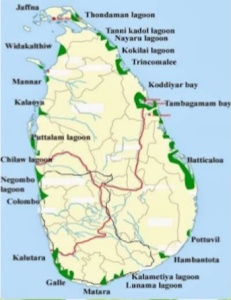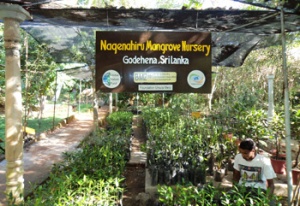“It is the responsibility and the necessity of all…to be united to protect the mangrove ecosystem.” – President Sirisena
How refreshing it is to see that Sri Lanka is leading the world in the conservation of its mangrove forests.
Two N.G.O.’s Seacology and Sudeesa (formerly known as Small Fishers Federation of Lanka) alongside the government of Sri Lanka have just announced a US$ 3.4 million project set to run until 2020 aimed at
- protecting all 8,815 ha of Sri Lanka’s existing mangrove forests.
- replanting an additional 9,600 acres (3,885 ha) in areas where mangroves have been cut down.
- establishing three mangrove nurseries to promote replanting efforts.
For a detailed look at one scheme also have a look at: The Chilaw mangrove project
Where are the mangrove forests?
There are three main areas of mangrove forest:
- The west coast; between Kalpitiya and Colombo
- The South coast especially between Kalutara and Galle
- The East coast from Batticaloa all the way along towards Jaffna
Threats
74% of mangrove forests have been lost in Sri Lanka since the 19th century. 30 years ago there were over 40,000 ha. of mangrove, now there are just 8000…most of it been destroyed due to commercial exploitation and firewood use.as well as the impacts of the war that raged from 1983 to 2009. It seems that most of the damage is in the past and was due to:
- prawn farming
- collateral damage from the civil war
- poor communities particularly along the East coast relied on mangrove forest as a source of firewood
Today those threats remain plus:
- clearance for tourist developments and hotel complexes
- coastal urban development more generally
- pollution from agricultural chemicals
Why protect the mangroves?
They are biologically rich ecosystems and are hauntingly beautiful but their value goes way beyond the aesthetic.
Mangroves are very productive ecosystems (on a par with tropical rain forest) with an economic value globally estimated to be more than US$ 186 million annually (according to the World Wildlife Fund. Why?
- Fisheries: Mangrove forests are not only home to a large variety of fish, crab, shrimp, and mollusc species, which form an essential source of food for thousands of coastal communities around the world. They are also nurseries for many fish species, including coral reef fish. This makes mangrove forests vitally important to commercial fisheries as well.
- Timber and plant products: Mangrove wood is resistant to rot and insects, making it extremely valuable. Many coastal communities rely on this wood for construction material as well as for fuel. These communities also collect medicinal plants from mangrove ecosystems and use mangrove leaves as animal fodder. Recently, the forests have also been commercially harvested for pulp, wood chip, and charcoal production.
- Coastal protection: The dense root systems of mangrove forests trap sediments flowing down rivers and off the land. This helps stabilizes the coastline and prevents erosion from waves and storms. In areas where mangroves have been cleared, coastal damage from hurricanes and typhoons is much more severe. When the 2004 Tsunami hit Sri Lanka the mangroves played an important role in slowing down the waves and giving people time to escape to safer ground. By filtering out sediments, the forests also protect coral reefs and seagrass meadows from being smothered in sediment.
- Tourism: The huge diversity of species is becoming increasingly attractive to tourists who are looking for more than just sun sea and sand based holidays
- Carbon Sink: It is now estimated that the mangrove forests play an important role in absorbing carbon dioxide from the atmosphere (carbon sequestration) . This is not just because of the large biomass of the forests. The forests are very efficient and transferring carbon to the soil.
“the .. implication of this is that the long term sequestration of carbon by 1kmsq of mangrove is equivalent to that occurring in 50kmsq of tropical forest”
Dr Emily Pidgeon: Conservation International
So if countries are serious about limiting carbon emissions the last thing they should be thinking of is removing their mangrove forests.
Sri Lanka leads the way
The Sri Lanka Mangrove Conservation project is being run by California based NGO Seacology alongside SUDEESA (formerly known as Small Fishers Federation of Lanka) and the government of Sri Lanka.
The $3.4million project aims to:
- Protect all 21,782 acres (8,815 ha) of Sri Lanka’s existing mangrove forests.
- Replant an additional 9,600 acres (3,885 ha) in areas where mangroves have been cut down.
- Establish three mangrove nurseries to promote replanting efforts.
The way it works is that if a village agrees to create or enforce a forest or marine reserve, Seacology will fund a key community need, such as a school or health clinic.
Putting women in charge is at the heart of the scheme. They will protect mangroves by ensuring no one in their communities, or from outside, cuts down the trees. If persuasion does not work they will be able to alert the authorities who are providing legislative support.
“We have discovered that if you want a project to succeed, have the women of the community run it,” said Anuradha Wickramasinghe, chairman of the Sri Lankan NGO Sudeesa. “Other conservation organisations have found the same thing.”
Where local communities agree to participate, the project will provide alternative job training and microloans to 15,000 poor women and their families, who live in 1,500 small communities adjacent to this nation’s mangrove forests. In exchange for receiving these microloans to start up small businesses, all 1,500 communities will be responsible for protecting an average of 21 acres of mangrove forest. A first-of-its kind mangrove museum to educate the public about the importance of preserving this resource will also be constructed as part of this project.
For a more detailed case study (with suggested tasks) check out https://geosrilanka.wordpress.com/2018/07/01/the-chilaw-mangrove-project-case-study-and-exercise/
Dual benefits
It is significant that the focus will be on women and the belief is that empowering women within the communities living close to the mangrove forests will have a major impact in raising living standards.
Sri Lanka’s emerging tourist industry can also benefit. Mangroves offer a new wildlife alternative for tourists; maybe to take some of the pressure off the heavily visited (over visited) national parks such as Yala
For too long mangroves have been seen simply as a wasteland to be cut down or removed to make way for commercial development but there is emerging a new more enlightened view and with it the hope that Sri Lanka’s existing mangrove forest can be protected and enhanced for future generations.
references and links:
local community involvement




